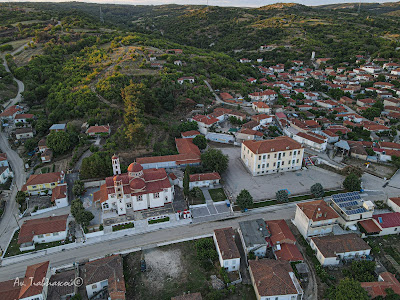Lavara: A heroic village in Evros!
Lavara is a village / town (κωμόπολη) of Evros, on the national road that connects Soufli with Didymoteicho. The village took its name from Lavaro (blue with a black cross in the middle) that 300 men raised on May 2, 1821, the day of the Removal of the Relics of Saint Athanasios, trapping the numerous Turkish army in the KOURI forest and after attacking them at night they dispersed them .
For two days the panicked Turks tried to get out of the forest and those who escaped went to the mountain village of Mavrokklisi. In 1834 the residents built the church of Agios Athanasios and in 1920 the renaming committee named the village Lavara in memory of the heroic battle.
In the past it was called Salia from the flat boats that crossed the Evros. Another version is that it comes from Sal = free because the inhabitants did not pay taxes to the Turks but only had the obligation to take care of and train the horses of the Sultans' guard.
Lavara (formerly Saltikioi) is a Greek village, former seat of the Municipality of Orfea, in the prefecture of Evros. Based on the Kallikratis Program on January 1, 2011 the municipality of Orfea was abolished and now forms the homonymous municipal unit of the Municipality of Soufli, with a population of 747 inhabitants in 2021, up from 1,093 in 2011. In the 17th century it was a capital village whose residents enjoyed tax exemption.
At that time it was called Saltikioi, which means a village where the "salia" are made, wide boats with a flat keel, with which the products were transported on the river Evros. The inhabitants participated in the Greek Revolution of 1821 with a revolutionary movement.
Historical data
The revolutionary movement of the inhabitants of the village of Saltikioi, today's Lavaras, in the period of April-May 1821, when its inhabitants neutralized a Turkish military force at the "Kuri" position, remains unknown. There are no surviving written sources for this revolutionary action. Tradition states that during the two-day battle the women of Lavara supplied food and ammunition to their more than 300 armed compatriots, traversing 10 kilometers of wooded area.
Until a few years ago, skeletons and pieces of broken weapons of the time were found at the site of the battle. Because the rebellious inhabitants of this village raised a blue flag with a black cross, for this reason in 1920, the toponyms committee gave the village this name "Lavara"
At the beginning of the 20th century, a Greek primary school with 100 students and a girls' school with 35 students were operating in the settlement
The church of Agios Athanasios
As a sign of gratitude for the sacrifice of their compatriots, the inhabitants of the village decided to build a church, which was completed in 1834 and is honored in the name of Agios Athanasios, because on his feast day (May 2) the great battle took place. The church of Agios Athanasios is a wooden basilica. Above the central entrance is the illegible inscription in Byzantine letters:
UTOS AND DIVINE HOLY TEMPLE
OF OUR HOLY FATHER
ATHANASIOU OF THE GREAT OF THE COUNTRY
SALTIKIOI RAISED FROM BATHRON
WITH THE PANIEROTATOU MIT/THE TWIN
BEAUTIFUL SUBSCRIPTION WALL AND NO
EXPENDITURE OF TE SORBATZIDES AND
OF ALL CHRISTIAN INHABITANTS
OF THIS COUNTRY
IN MEMORY OF THEM IN ETEI 1834
AND OCTOBER 24 EASTER JOURNEY
Vangelis Matsianis, a famous chieftain of Thrace in the 19th century, came from Lavara. In 2006 the area was hit by severe floods, caused by a large descent of water volumes from Bulgaria.
Lavara today is faced with thousands of illegal immigrants. The Turkish Military Border Guards have created an "inflow line into Greece through the Lavars".
A video that has come to light shows the way in which Turkish military guards promote migrants to the Evros.
In the images broadcast by the Open TV station, irregular migrants can be seen crossing the river Evros, without a boat. Holding a rope, they swim across the river from the Turkish side to the opposite bank, in Greek territory, at the height of the villages of Amorio and Lavara. The Turkish military guards are there, next to them and help them to enter Greek territory.
Watch the video HERE
In an effort to reduce the number of illegal immigrants, a fence has been installed which does absolutely nothing since anyone can break through it with a simple knife..




.jpg)





Σχόλια